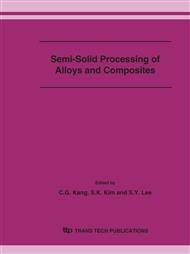p.578
p.583
p.587
p.591
p.596
p.601
p.606
p.610
p.614
Thermo-Mechanical Modeling of the Cooling Process during Thixoforging of Fiber Reinforced Light Metal Composites
Abstract:
Light-metal matrix composites with tailor-made fiber reinforcements offer a good balance between weight saving and high strength, a key feature for lightweight design in structural applications for the automotive and aerospace industry. Light-metal MMCs manufactured by thixoforging of thermally sprayed prepregs additionally exhibit superior mechanical properties of the matrix material as well as low fiber damage during infiltration of the reinforcement fabric. However, one of the difficulties during manufacturing of these materials is the difference in the thermal expansion coefficients (CTE) of matrix and fiber material. Different thermal expansions lead to the development of residual stresses during the cooling process that can deform the reinforcement fibers and hence, lead to a decrease of the mechanical properties of the reinforced component. Modeling by means of finite elements and numerical simulation is used in order to study parameter variations during the cooling procedure and to select an optimized process route. The modeling and simulation was performed in a collaborative work between the Institute for Manufacturing Technologies of Ceramic Components and Composites, University of Stuttgart, and the Polytechnic University of Cartagena.
Info:
Periodical:
Pages:
596-600
Citation:
Online since:
October 2006
Authors:
Price:
Сopyright:
© 2006 Trans Tech Publications Ltd. All Rights Reserved
Share:
Citation:


